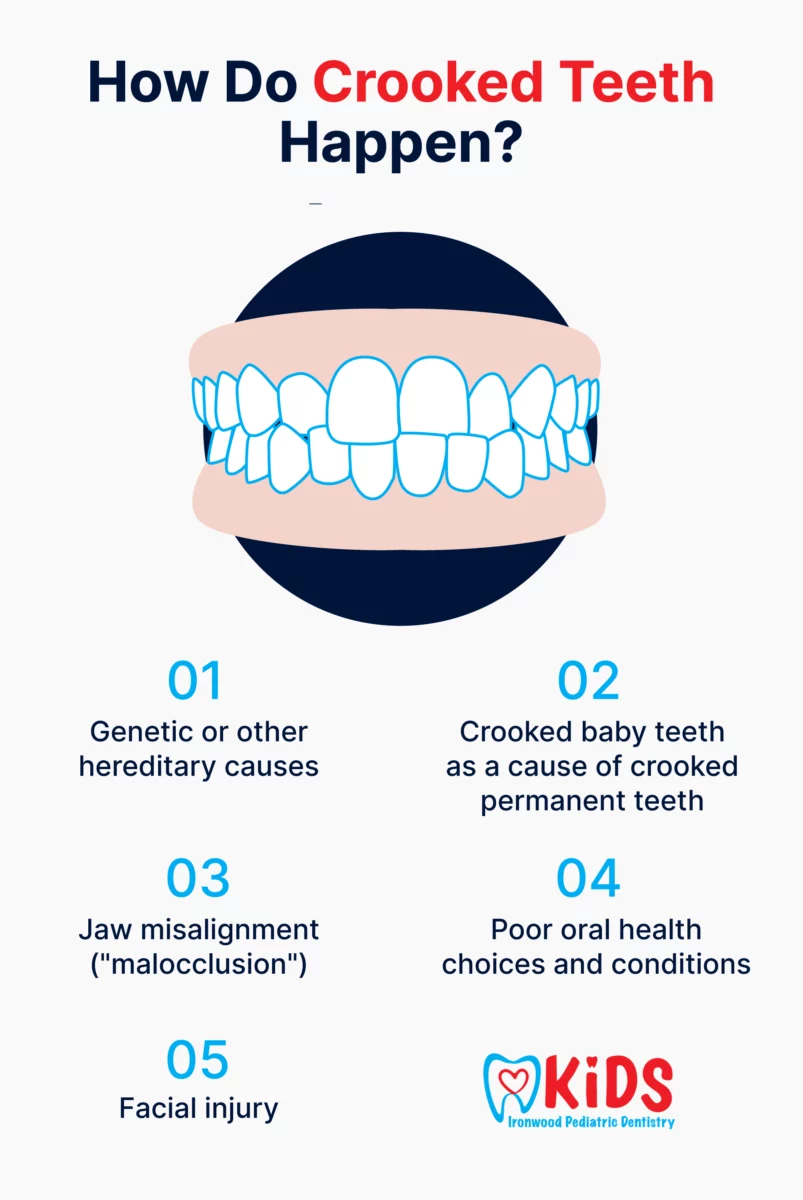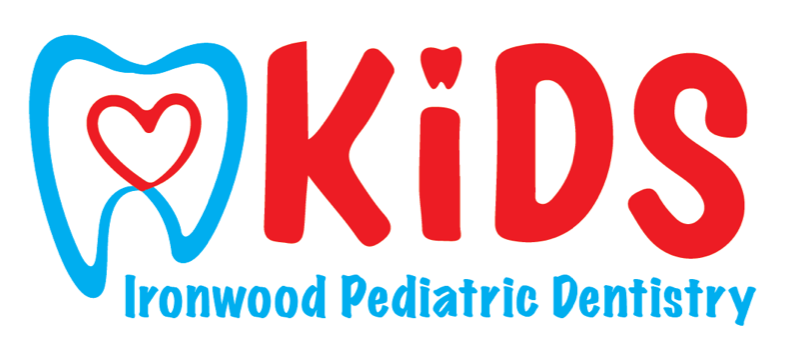If your child has misaligned or “crooked” teeth, then know that this is a common childhood condition that orthodontic treatment can fix. This post discusses what causes crooked teeth in children and how an orthodontic treatment plan can help your child go from misaligned teeth to a bright and healthy smile.
If you would like to explore orthodontic treatment for your child, call Ironwood Pediatric Dentistry at (480) 422-4544 or use our contact form to set up an appointment.
Genetic or Other Hereditary Causes
If one or both parents had crowded or crooked teeth as children, their children are more likely to experience the same issues.
These inherited characteristics can lead to problems with crooked teeth that neither you nor your child have any control over. Some of these are:
- Crowded teeth
- Problems with jaw shape development
- Overbites and underbites
- Poor palate development

Crooked Baby Teeth as a Possible Cause of Crooked Permanent Teeth
Baby teeth can get out of proper position because they are not big enough to fill out your child’s available gum space. Or, the opposite situation can occur, with the baby teeth becoming too crowded together.
Losing baby teeth too soon can allow other teeth to shift into the gaps, which can interfere with the proper positioning of the permanent teeth as they begin to erupt.
Jaw Misalignment (“Malocclusion”)
When your child’s jaws are in proper alignment, the upper teeth fit slightly over the lower teeth. The points of the upper molars fit into the grooves of the lower molars.
When the jaws do not align well, dentists and orthodontists call this a malocclusion. Malocclusion is a very common cause of crooked baby teeth and crooked permanent teeth.
The effects of malocclusion are different depending on how the upper and lower teeth are out of alignment. Variations include:
- Overbite: the upper front teeth protrude, or stick out, further in front of the lower front teeth.
- Underbite: the lower front teeth protrude further forward than the upper front teeth.
Bad Oral Hygiene
Most parents and children know about the importance of brushing their teeth at least twice daily and flossing at least once a day. But there is a difference between knowing what to do and doing what we know. Many children do not brush their teeth as often as they should or floss their teeth at all.
Lack of proper teeth cleaning can contribute to dental health problems like gum disease and its more advanced form, periodontal disease. Unhealthy gums make it easier for teeth to become loose, which can lead them to shift out of proper position, causing malocclusion and a misaligned smile. In the worst case, unhealthy gums can even lead to tooth loss.
Lack of Adequate Dental Care
Having your child visit the dentist for regular check-ups and teeth cleanings is an important way to reinforce the effects of good oral health behaviors like tooth brushing and flossing.
Also, these regular appointments are excellent opportunities for your child dentist to spot developing malocclusion conditions in time to begin treating them in a timely and effective way.
Poor Nutrition
Poor childhood nutrition can lead to dental health problems, including tooth decay and gum disease. As we have shown above, gum disease, in particular, can lead to crooked teeth.
Unhealthy Habits
Children can often develop behavioral patterns that, if not corrected, can make crooked teeth more likely to happen. These include:
- Digit sucking, most notably thumb sucking. This can lead to overbite problems with the upper front teeth.
- The use of a pacifier for too long can have the same negative effect as digit sucking.
- Tongue thrusting is when a child develops the habit of pressing the tongue against the roof of the mouth, particularly when swallowing. This can lead to an overbite condition if it goes on long enough.
- Mouth breathing in children may impact tooth alignment because it can lead to dry mouth, making gum disease more likely to develop.
Facial Injury
A blow to the face or mouth can move teeth out of place or result in one or more lost teeth. Either of these can lead to malocclusion problems.
What Are the Effects of Crooked Teeth?
The most visible consequence of a malocclusion problem is a crooked smile. This can cause your child to become self-conscious and afraid to smile, which can lead to feelings of social awkwardness and low self-esteem.
Less visible effects can be health-related:
- Gum disease
- Excess and uneven wear on tooth enamel surfaces, which can contribute to tooth decay
- Possible tooth chipping or breakage
- Speech problems
- Jaw pain
- Chronic headaches
- Problems with thoroughly chewing food, which can lead to digestive problems
How Does Orthodontic Treatment Fix Crooked Teeth?
Your child’s dentist will often be the first person to spot a developing crooked teeth problem. When this happens, the dentist may refer you to an orthodontist for further evaluation and to review treatment options with you.
Depending on your child’s specific problems, your orthodontist can suggest one of multiple effective orthodontic treatment choices.
Traditional Dental Braces
Traditional braces are a cost-effective option suitable for treating all misalignment problems except those that need surgery. They can cost between $3,000 and $7,000 and take one to three years to treat crooked teeth.
Traditional braces fix crooked teeth with metal brackets, elastic bands, and a flexible archwire. Because of their proven effectiveness and relatively low cost compared to other orthodontic treatment options, metal braces are the most frequent treatment choice.
The main downside of traditional braces is their visibility. Compared to some options, like removable clear plastic aligners, they can make it more challenging to keep teeth clean by brushing and flossing.
Clear Plastic Removable Aligners
Also known as invisible braces, clear plastic aligners like Invisalign aligners are made of clear plastic trays that fit over the teeth and are removable. They cost about the same in most cases as ceramic braces.
Unlike traditional braces, clear plastic aligners work in multiple sets of custom-fitted trays that are replaced about every two weeks. Each tray builds on the gradual tooth realignment progress of the prior trays.
Compared to fixed braces, the advantages of clear plastic aligners are:
- They are very hard to see when worn.
- They can be removed when eating or drinking, meaning they are not subject to the same restrictions on sticky or hard foods as braces.
The potential downsides of clear aligners include:
- They are most effective for minor tooth misalignment problems. They are not as effective for more complex orthodontic treatment needs.
- If left on when drinking colored fluids, like fruit juices, coffee, or tea, they can stain.
- They need to be regularly cleaned to keep them from becoming cloudy and to prevent plaque buildup from harmful bacteria on their surfaces.
- They require diligence and self-discipline. To work properly, clear aligners need to be worn every day for about 20 to 22 hours. Otherwise, the straightening process from one set of trays may not be enough for the next set to work efficiently, which can require adjustment to the treatment plan.
Palatal Expander
For small children, sometimes their mouths can be too small to allow for proper eruption of their permanent teeth. In these cases, your orthodontist may use a palatal expander to expand the roof of the mouth. A palatal expander is held in place by a dental bonding material and allows for additional bone growth in the upper jaw, thereby expanding the width of the mouth as a whole.
Retainers
Retainers are usually used after the completion of braces treatment. Their purpose is to make sure that the tooth realignment from braces stays in place after braces are removed. In a few situations, when a tooth misalignment problem is minor, retainers might be used as an alternative to braces or aligners.
Teeth-Straightening Surgery
For particularly serious orthodontic issues, which often involve severe misalignments beyond crooked teeth, braces alone might not be enough. In these cases, your orthodontist may refer your child for orthodontic surgery.
Orthodontic surgery is something your orthodontist will consider, for example, if your child’s oral health problems affect the ability to chew food or cause speech issues.

Does Your Child Have Crooked Teeth?
Ironwood Pediatric Dentistry offers child orthodontic services to help fix your child’s crooked teeth. We can help you correct your child’s misaligned bite by offering the full range of orthodontic treatment options from traditional braces to Invisalign treatment.
Call us at (480) 422-4544 or use our contact form to schedule an appointment or ask a question.
